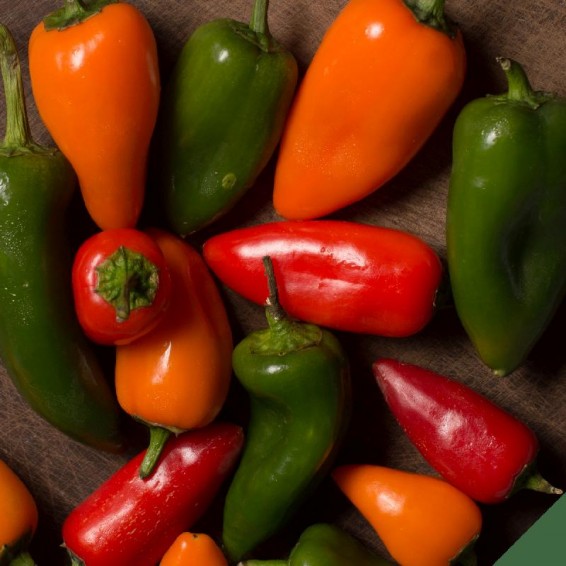Organic Rio Grande Hot Pepper Seeds
- HOW TO GROW
- FAST FACTS
- REVIEWS
HOW TO GROW
Sowing: Start pepper seeds indoors in peat pots about 8 weeks before the last expected spring frost. Sow them 1/4" deep and keep the soil at 80-85 degrees F until germination; provide sunlight or a grow light for 12-16 hours a day. When the outdoor temperature reaches 60-65 degrees F during the day and no less than 50 degrees F at night, transplant the seedlings. Exposing the plants to the weather for several hours a day before transplanting may help prevent shock.
Growing: Keep the soil evenly moist and weeds under control; mulching the plants may help with this. If excess heat and sun cause the plants to wilt, provide shade.
Harvesting: Harvesting peppers is basically a matter of personal preference. Generally, the longer the peppers mature on the vine, the hotter they will taste. Mature peppers, however, signal the plant to stop producing; if the peppers are picked when still at the green stage, the plant will go on producing. Always use a knife or scissors to remove peppers to prevent damage to the fragile stems.
Seed Saving: Keep in mind that peppers will cross pollinate with other varietes of pepper, so isolation or caging may be necessary to preserve genetic purity. Allow the pepper to fully mature, than cut it open and remove the seeds. Spread out the seeds to dry for about two weeks. Store the seeds in a cool, dry place for up to two years.
FAST FACTS
Latin Name: Capsicum annuum
Type: Open Pollinated, Hot Pepper, Warm Season
USDA Zones: 3, 4, 5, 6, 7, 8, 9, 10, 11, 12
Seeds per Ounce: 3,750
Planting Method: From Transplant
Sunlight: Full Sun
Height: 24 Inches
Color: Red, Green
Did Not Sprout
I ordered the same seeds from am etsy vendor because everwilde was out at the time. About a week later I noticed everwilde had gotten theirs back in, so I ordered a pack from them also. Both vendors were stingy with the amount of seeds. I think their were around 18 to 24 seeds in the pack from both vendors. Only 1 seed sprouted from everwilde. About 90% of the seeds I got from the etsy vendor sprouted, so I know it wasn't anything I did. I ordered 3 more packs from everwilde, thinking I may have gotten a bad batch. None of those came up at all. I had a lot of confidence in everwilde, because I have always gotten good results and generous amounts of seeds in the past. Now I am hesitant to order from them. I really hope this was just a bad year for these seeds. I also hope the reason for the stingy amount of seeds had something to do with seed shortages.
DESCRIPTION
HOW TO GROW
Sowing: Start pepper seeds indoors in peat pots about 8 weeks before the last expected spring frost. Sow them 1/4" deep and keep the soil at 80-85 degrees F until germination; provide sunlight or a grow light for 12-16 hours a day. When the outdoor temperature reaches 60-65 degrees F during the day and no less than 50 degrees F at night, transplant the seedlings. Exposing the plants to the weather for several hours a day before transplanting may help prevent shock.
Growing: Keep the soil evenly moist and weeds under control; mulching the plants may help with this. If excess heat and sun cause the plants to wilt, provide shade.
Harvesting: Harvesting peppers is basically a matter of personal preference. Generally, the longer the peppers mature on the vine, the hotter they will taste. Mature peppers, however, signal the plant to stop producing; if the peppers are picked when still at the green stage, the plant will go on producing. Always use a knife or scissors to remove peppers to prevent damage to the fragile stems.
Seed Saving: Keep in mind that peppers will cross pollinate with other varietes of pepper, so isolation or caging may be necessary to preserve genetic purity. Allow the pepper to fully mature, than cut it open and remove the seeds. Spread out the seeds to dry for about two weeks. Store the seeds in a cool, dry place for up to two years.
FAST FACTS
Latin Name: Capsicum annuum
Type: Open Pollinated, Hot Pepper, Warm Season
USDA Zones: 3, 4, 5, 6, 7, 8, 9, 10, 11, 12
Seeds per Ounce: 3,750
Planting Method: From Transplant
Sunlight: Full Sun
Height: 24 Inches
Color: Red, Green
Reviews
Review
Did Not Sprout
I ordered the same seeds from am etsy vendor because everwilde was out at the time. About a week later I noticed everwilde had gotten theirs back in, so I ordered a pack from them also. Both vendors were stingy with the amount of seeds. I think their were around 18 to 24 seeds in the pack from both vendors. Only 1 seed sprouted from everwilde. About 90% of the seeds I got from the etsy vendor sprouted, so I know it wasn't anything I did. I ordered 3 more packs from everwilde, thinking I may have gotten a bad batch. None of those came up at all. I had a lot of confidence in everwilde, because I have always gotten good results and generous amounts of seeds in the past. Now I am hesitant to order from them. I really hope this was just a bad year for these seeds. I also hope the reason for the stingy amount of seeds had something to do with seed shortages.





